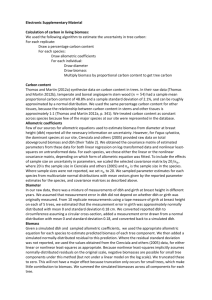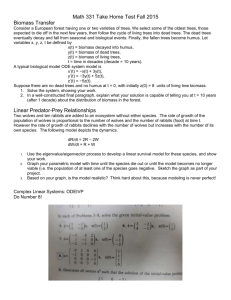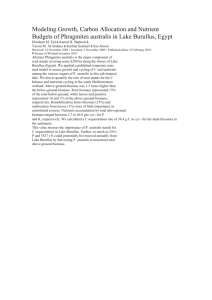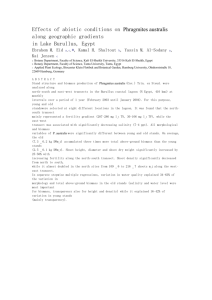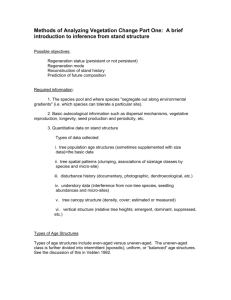Population structure and above giomass of mangrove Avicennia
advertisement
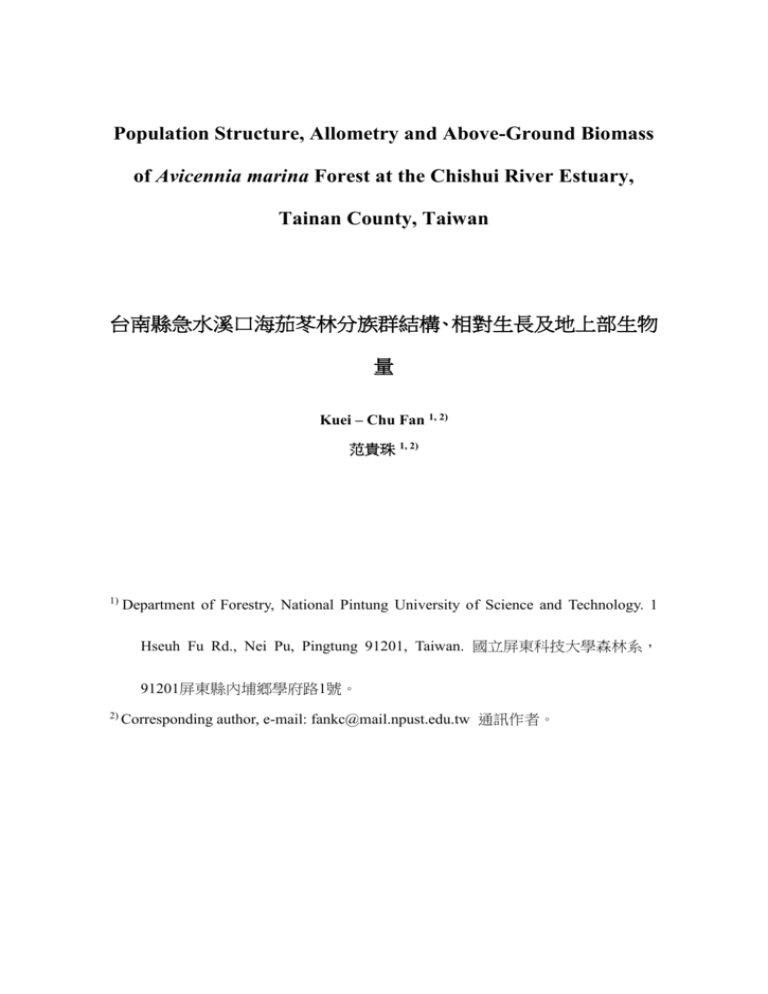
Population Structure, Allometry and Above-Ground Biomass of Avicennia marina Forest at the Chishui River Estuary, Tainan County, Taiwan 台南縣急水溪口海茄苳林分族群結構、相對生長及地上部生物 量 Kuei – Chu Fan 1, 2) 范貴珠 1, 2) 1) Department of Forestry, National Pintung University of Science and Technology. 1 Hseuh Fu Rd., Nei Pu, Pingtung 91201, Taiwan. 國立屏東科技大學森林系, 91201屏東縣內埔鄉學府路1號。 2) Corresponding author, e-mail: fankc@mail.npust.edu.tw 通訊作者。 Population Structure, Allometry and Above-Ground Biomass of Avicennia marina Forest at the Chishui River Estuary, Tainan County, Taiwan Kuei-Chu Fan1,2) 【Summary】 This study investigates the structure and above-ground biomass of an Avicennia marina forest located at the mouth of the Chishui River, in Tainan County, Taiwan. Four mangrove stands with various characteristics and density were studied, including sea edge pioneer (Stand I at the northern river bank) and young mangroves (Stands II and III at the northern river bank; Stand IV at the southern river bank). The tree heights of these four mangrove stands varied from 0.9 to 1.2 m, diameter at breast height (DBH) ranged from 2.4 to 5.1 cm, and tree density ranged from 5,029 to 17,000 trees ha-1. The distribution of DBH was skewed to small classes, and all sampled trees showed reverse J-shaped distributions, which suggested an active regeneration in these populations. The allometric relationships derived by regressions of leaves, stems, branches, and total above-ground biomass vs. DBH of A. marina trees, for each tree component were highly significant, with R2 values from 0.750 to 0.956. Total above-ground biomass was estimated as a power function of the DBH as an independent variable, WT = 0.1012 (DBH2) + 0.5402 (DBH) - 1.5674, where WT = above-ground biomass (kg). The 1 allometric relationship was used to estimate total above-ground biomass, which varied from 10.3 ton ha-1 for the pioneer stage (Stand I, near the river mouth) to 22.7 ton ha-1 for a more mature mangrove at the upstream of the river, indicating that this A. marina forest at the Chishui River estuary mouth has less above-ground biomass than these forests elsewhere in the world. Key words: population structure, allometry, above-ground biomass, mangrove, Avicennia marina. -------------------------------------------------------------------------------------------------------1) Associate Professor, Department of Forestry, National Pintung University of Science and Technology. 1 Hseuh Fu Rd., Nei Pu, Pingtung 91201, Taiwan. 2) Corresponding author, e-mail: fankc@mail.npust.edu.tw 2 台南縣急水溪口海茄苳林分族群結構、相對生長及地上部生物量 范貴珠1,2) 摘要 本研究調查台南縣急水溪口海茄苳(Avicennia marina)林分之結構與地上部生 物量,所調查 4 個不同特性及密度之林分,包括向海之先驅林分(北岸之 Stand I) 及幼齡林(北岸之 Stand II 及 III;南岸之 Stand IV)。四個林分之樹高在 0.9~1.2 m 間,胸高直徑(DBH)在 2.4~5.1 cm 間,而林分密度則為 5,029~17,000 trees ha-1。林 木胸高直徑分布多為小徑木,而所有樣木胸徑分布呈反 J 形,顯示此族群呈現更新 良好狀態。本研究建立海茄苳葉部、莖部、枝條、總地上部生物量與 DBH 之異速 生長回歸式,顯示林木各部位乾重之 R2 值在 0.750~0.956 間。而利用推估地上部 生物量之最佳函數 DBH 為獨立變數,以 WT = 0.1012 (DBH2) + 0.5402 (DBH) 1.5674 公式計算地上部生物量(WT)結果顯示,先驅林分(Stand I,近河口處)之生物 量為 10.3 ton ha-1, 河流上游較成熟林分為 22.7 ton ha-1,急水溪口海茄苳林分地 上部生物量較世界其他國家為低。 關鍵詞: 族群結構、相對生長、地上部生物量、紅樹林、海茄苳。 ---------------------------------------------------------------------------------------------------------1) 國立屏東科技大學森林系副教授,91201屏東縣內埔鄉學府路1號 2) 通訊作者,e-mail: fankc@mail.npust.edu.tw 3 INTRODUCTION Mangroves are abundant in tropical and Southeast Asia and are one of the most productive and important coastal communities in these regions because they are the base of food chains and provide feeding and nursery areas for commercial fish stocks (Tomlinson, 1994; Kathiresan and Bingham, 2001). Recently, mangrove habitats are increasingly threatened by local, regional and potentially global changes (Kathiresan and Bingham, 2001; Cohen et al., 2005). Managing a mangrove ecosystem requires information to understand and predict changes in ecosystem structure and function. Accurate estimates of biomass are important for describing the current state of mangrove forests and for predicting the consequences of change (Steinke et al., 1995; Comley and McGuinness, 2005). Although many papers have been published on different aspects of mangrove ecology, few publications have focused on the mangrove forest structure (Day et al., 1987; Osunkoya and Greese, 1997; Fromard et al., 1998; Fernandes, 2000). The structural characteristics of a mangrove forest are influenced by the magnitudes and periodicity of forcing functions related to various environmental parameters, such as light intensity, soil fertility, salinity, pH and competition (Koch and Snidaker, 1997; Ukpong, 1997; Sherman et al., 1998; Tam and Wong, 1998). Allometric relations are defined as “characterizing harmonious growth with 4 changing proportions”, usually with a logarithmic association (Turner et al., 1995; Smith III and Whelan, 2006). They are developed by establishing relations between some easily measured individual plant parameter(s) and some variable that is much harder to measure. Many researchers have developed relations to predict above-ground biomass using DBH for mangroves from a variety of areas (Clough and Scott, 1989; Amarasinghe and Balasubramaniam, 1992; Saenger and Snedaker, 1993; Steinke et al., 1995; Turner et al., 1995, Clough et al., 1997; Smith III and Whelan, 2006). However, no allometric equations have been developed for mangroves in Taiwan, an area at the northern limit of their distribution, which is 25oN latitude. Avicennia marina is the most important species in southern Taiwan. Vast areas of mangrove in the region are mixed with Rhizophora stylosa and Lumnitzera racemosa, often as pure stands or growing along the channel side. The purpose of this work was to estimate the population structure and to develop allometric relations for leaves, stems, branches and above-ground biomass on DBH for an A. marina forest in the Chishui River, Tainan County, Taiwan. A better understanding of the growth characteristics of this species is important for the management of this rare and unique ecosystem. 5 MATERIALS AND METHODS Study site The studies were carried out at the Chishui River estuary (23o 18’ 02.6” to 23o 17’ 55.8” N; 120o 06’ 20.8” to 120o 06’ 39.9”W), in Tainan County, Taiwan (Fig. 1). This area contains monospecific stands of A. marina. Most of the trees developed at the northern bank of the river mouth, although many young trees and saplings grow at the southern of the river mouth near the sea. In total, it contains 28.5 ha of mangroves. Climatic data from the nearest Tainan meteorological station, indicate that the mean annual temperature is 24.1℃, mean monthly temperature is 17.3℃ in January, and 29.0℃ in July, and annual precipitation is 1672.4 mm. In the mangrove distribution area of the Chishui River mouth, the average tidal range is 1.3 m, with a maximum of about 1.8 m. 6 Fig. 1. Location of above-ground biomass sampled stands of Avicennia mangrove at the Chishui River estuary. Plot design In the Avicennia genus, growth rings are present but not correlated with the age of a given individual. The number of rings in a given stem section is related to its diameter but varies within sections of the same age (Gill 1971). In October 2003, four 7 characteristic mangrove stages were distinguished, each occurring in four areas: sea edge pioneer (Stand I at northern bank) and young mangroves (Stands II and III at northern bank; Stand IV at southern bank)(Fig. 1). Each stand consisted of 4 to 10 adjoining plots with a surface area fixed by the density of the populations: 5 × 5 m for pioneer (Stand I) and young (Stand II) mangroves; and since the areas of Stands III and IV were much wider, the plots for these two young mangroves were set at 10 × 10 m. Stand structure The height and diameter at breast height (1.3 m) (DBH) of all trees ≧ 2 cm in diameter were measured and recorded. When substems branched from a main stem at a height lower than 30 cm, all the stems of an individual tree were investigated for the analysis of forest biomass. Above-ground biomass of individual tree For estimating the above ground biomass of the forest, 20 A. marina trees were investigated in order to establish allometric equations. The diameters (DBH) and the heights of all the trees cut were measured. Stems, branches, leaves were sorted and weighed on site (fresh weight). Dry weights were obtained by drying sub-samples 8 materials to constant weight in an oven at 75℃. The dry weights of each sampled individual was then described by its structure parameters and the portions (stems, branches, leaves) as well as the total biomass. Establishment of allometric relationships In this work, the predictive variable used the diameter to present the biomass for A. marina., and various forms of regression were tested. Depending on the statistical characteristics of the results (regression coefficients), different models gave the best description of the relationship between leaves, stems, branches, total biomass (WL, WS, WB, WT) and diameter (DBH). The established models were then applied to all the individuals in the plots. Total biomass of a plot is equal to the sum of the individual masses expressed in tonnes dry weight per hectare (methods adapted from studies performed by Clough et al., 1997; Komiyama et al., 2000). Soil analysis At each stand, soil samples were collected at 20 cm depth using a soil corer. The soils were dried at room temperature, after which they were ground and passed through a 2 mm mesh sieve. The pH of the soils was measured in a 1:2 soil-to-water suspension and the cation-exchange capacity (CEC) was measured by ammonium acetate saturation. 9 Total Kjeldahl nitrogen digestion using concentrated H2SO4 and Cu catalyst was followed by Markham distillation. Available phosphorus was extracted with NaHCO3, and exchangeable potassium, calcium, magnesium, sodium were extracted with neutral NH4OAc, followed by flame emission for Na and K, and the atomic absorption spectrometry for Ca and Mg (Kalra and Maynard, 1991). RESULTS Characteristics of different stands Tree height, diameter and density differed markedly among the stands (Table 1). The taller trees occurred in Stands II and III (height range 2.6 to 2.9 m), medium-sized tree (2.3 m) in Stand IV, and dwarf trees (2.0 m) in Stand I. Trees in Stand III exhibited the largest DBH (5.1 cm), and trees in Stands II and IV had the same DBH of 4.1 cm; in particular, most trees in Stand IV were multi-stem and short. The smallest ones occurred in Stand I, where the average DBH of trees was merely 2.4 cm. However, the mangroves in this area exhibited the highest density (17,000 trees ha-1) of all investigated forests. Stem density of Stand II decreased to 9,400 trees ha-1 and Stand III showed the lowest density, only 4,225 trees ha-1. 10 Table 1. Characteristics of A. marina at different stands at Chishui River estuary Plot Position Tree height (m) Diameter (DBH)(cm) Stem density (trees ha-1) 2.0 ± 0.3 c 2.4 ± 0.7c 17000 ± 1235a 2.6 ± 0.4 ab 4.1 ± 1.2b 9400 ± 1088b Stand III 2.9 ± 0.3 a 5.1 ± 0.6 a 5029 ± 718 d South bank Stand IV 2.3 ± 0.5 b 4.1 ± 0.5 b 6510 ± 885c Stand I North bank Stand II * In each column, the means with a same letter do not differ significantly at p < 0.05, according to the Duncans’s test (The values present as mean ± standard error). Frequency distribution of height and diameter The total number of A. marina trees in all plots was 996. The frequency distributions for H showed normal distribution and were slightly skewed to the small (1.6~2.0) and medium (2.1~3.0 m) classes (Fig. 2a), as compared to means (H = 2.6 m). There were very few trees over 4.0 m. The distribution of DBH was skewed to the small classes (Fig. 2b). In all plots, A. marina trees consisted of two small individuals (DBH = 2.1~4.0 cm and DBH = 4.1~6.0 cm), there were only 6 trees with DBH > 12 cm. The DBH of all sampled trees showed reverse J-shaped distributions. 11 Number of trees 300 270 268 a 250 198 176 200 150 100 50 56 19 9 0 1.0-1.5 1.6-2.0 2.1-2.5 2.6-3.0 3.1-3.5 3.6-4.0 4.1-4.5 Tree height classes (m) b Number of trees 700 600 y = 1652.1e 513 2 R = 0.9901 500 400 -0.9412x 309 300 200 119 100 36 13 6 8.1-10.0 10.1-12.0 >12.1 0 2.1-4.0 4.1-6.0 6.1-8.0 DBH classes (cm) Fig. 2. Frequency distributions of the tree height (a) and DBH (b) classed in all sampled plots. Allometric relationships The allometric relationship of tree height vs. DBH used the equation: H = -0.0108 × DBH2 + 0.3191 × DBH + 1.4533. However, the tree height was not significantly 12 correlated with trunk diameter (R2 = 0.4163) in that tree height did not increase with increasing DBH of A. marina trees. Using the data obtained from individually sampled A. marina trees, the allometric relationships for WL, WS, WB and WT were examined with the variables of DBH. Highly significant relationships were found for all components of biomass and DBH, especially in the relationship for WS and WT , the values of R2 were significantly high 3.0 y = 0.0025x 2.5 Branches dry weight (kg) Leaves dry weight (kg) (0.9564 and 0.9377, respectively) (Fig. 3.). 3.242 2 R = 0.8008 2.0 1.5 1.0 0.5 0.0 2.5 1.9607 y = 0.0305x 2.0 2 R = 0.7698 1.5 1.0 0.5 0.0 0 2 4 6 8 10 0 2 4 6 8 10 8 10 DBH (cm) 8.0 12.0 y = 0.1036x2 - 0.0939x + 0.0096 7.0 6.0 Total dry weight (kg) Stems dry weight (kg) DBH (cm) R2 = 0.9564 5.0 4.0 3.0 2.0 1.0 0.0 2 y = 0.1012x + 0.5402x - 1.5674 10.0 R2 = 0.9377 8.0 6.0 4.0 2.0 0.0 0 2 4 6 8 10 0 DBH (cm) 2 4 6 DBH (cm) Fig. 3. Allometic relationships for the leaves (a), stems (b), branches (c), total biomass (kg)(d) on DBH of A. marina trees at Chishui River estuary. 13 Using the best curve, WT = 0.1012 (DBH2) + 0.5402 (DBH) - 1.5674, where WT = above-ground biomass (kg), gave a very good estimate of biomass (R2 = 0.9377, p < 0.01). Calculating for all trees in the sampled plots, the total above-ground biomass for Stands I to IV were 13.5, 10.3, 22.7 and 21.0 ton ha-1, respectively (Fig. 4.). The -1 Above-ground biomass (ton ha ) average above-ground biomass of these stands was estimated as 16.9 ton ha-1. 30.0 a a Stand III Stand IV 25.0 20.0 b b 15.0 10.0 5.0 0.0 Stand I Stand II Position Fig. 4. Total above-ground biomass (ton ha-1) at different A. marina stands at Chishui River estuary. Soil Characteristics There was no significant difference of soil pH between the four stands, with a range of 7.78 to 7.90, indicating slightly alkaline soil. Integratively, concentrations of N, 14 P, K, Na, Ca, Mg and C.E.C of soil were higher in the seaward forests (Stands I and IV). Concentrations of N, P, K, Na, Mg and C.E.C of soil were lowest in the upstream forest (Stand III) (Table 2). Table 2. Soil Characteristics at different A. marina stands at Chishui River estuary Stand I Stand II Stand III Stand IV pH 7.78 ± 0.39NS 7.90 ± 0.14 7.79 ± 0.16 7.71 ± 0.08 N (%) 1.47 ± 0.04 a 1.12 ± 0.04b 1.09 ± 0.10b 1.35 ± 0.18a P (ppm) 13.43 ± 3.14b 13.41 ± 1.32b 13.22 ± 0.59b 16.81 ± 0.97a K(m.e./100g) 2.42 ± 0.79a 2.14 ± 0.21a 1.30 ± 0.14b 2.30 ± 0.02a Na(m.e./100g) 36.56 ± 1.90a 24.95 ± 1.39b 23.56 ± 1.10b 30.56 ± 0.60a Ca(m.e./100g) 7.85 ± 0.44a 7.63 ± 0.05a 7.96 ± 0.59a 6.83 ± 0.14b Mg (m.e./100g) 11.59 ± 3.21a 9.41 ± 0.15b 6.59 ± 0.62c 11.16 ± 0.25a C.E.C. (m.e./100g) 14.49 ± 1.39a 13.29 ± 0.40a 10.23 ± 0.71b 13.40 ± 0.57a * In each row, the means with a same letter do not differ significantly at p < 0.05, according to the Duncans’s test (The values present as mean ± standard error). DISCUSSION Characteristics of different stands The diameter (DBH) and tree height are important structural parameters that affect the density and influence the spatial distribution of the individuals in a certain plant community. Consequently, the relationship between these two parameters results in a 15 positive correlation which can be used to express as the degree of development of a stand (Fernandes, 2000). In this study, tree height, diameter and density differed markedly among the Avicennia stands at Chishui River estuary (Table 1). The taller trees (2.9 m) and largest DBH (5.1 m) occurred in Stand III, indicating that this stand was established much earlier than other stands; moreover, the self-thinning process occurs in a mangrove community, and trees with larger diameters are usually carried out by continuous drying and breaking of branches. This ecological phenomenon is closely related to population, community construction, age construction and natural geographical position (Fromard et al., 1998; Liao et al., 2004; Ward et al., 2006). Accordingly, Stand III showed the lowest density, only 4,225 trees ha-1 (Table 1). Tree height and DBH decreased with the distance from river mouth, however, this distance increased the stand density, ie. medium-sized trees (4.1 m in DBH) occurred in Stands II and IV, and trees in Stand I were short and stunted, with the highest density (17,000 trees ha-1). This indicated that the A. marina population in Chishui River spread from upstream toward the sea. A. marina stands in North Island of New Zealand (Osunkoya and Greese, 1997) and at Anping Harbor in Taiwan (Fan et al., 2006) also showed a similar spread pattern. Frequency distribution for tree height of A. marina at Chishui River estuary had a 16 normal distribution and was slightly skewed to the smaller (1.6~3.0 m) classes (Fig. 2a). The distribution of DBH was also skewed to the smaller classes (Fig. 2b), all sampled trees showed reverse J-shaped distributions. These results were similar to Avicennia spp. mangrove forests in New Zealand (Osunkoya and Greese, 1997) and Oman (Naoko et al., 2003), suggesting active regeneration in these populations. The R2 value between diameter and height of A. marina in Shinas (northern part of Oman) is 0.5929, although in Quriyat (central part of Oman) it is 0.1764 (Naoko et al., 2003). This study used the equation: H = -0.0108 × DBH2 + 0.3191 × DBH + 1.4533, although tree height was also not significantly correlated with trunk diameter (R2 = 0.4163). This was because the tips of Avicennia spp. often break off and apical growth is replaced by an axillary branch, so the diameter/height correlation therefore no longer has the same biological significance (Fromard et al., 1998). In our study, this phenomenon occurred mostly at the seaward land of the river estuary (Stands I and IV). Allometric relationships Both stem height and DBH are excellent predictors of total above ground biomass for mangrove forest (Saenger and Snedaker, 1993; Smith and Whelan, 2006). However, attempts to use height as a parameter were not successful in this study, since no 17 relationship between height and the above-ground biomass components was not found for the Chishui River mangroves (Biomass = a Height b, R2 = 0.3808~0.6011). In practice, DBH was measured very accurately and with great ease in the field, whereas stem height is very difficult to measure non-destructively, especially in a muddy mangrove forest (Steinke et al., 1995; Fromard et al., 1998), and so most authors have simply used DBH to study allometric relationships of mangrove forests (Clough and Scott, 1989; Steinke et al., 1995; Clough et al., 1997; Fromard et al., 1998; Comley and McGuinness, 2005; Smith and Whelan, 2006). In estimates from specific trees harvested in this study, the leaves, stems, branches and total above-ground total biomass were clearly related to the variable DBH (Fig. 3). The allometric relationships with DBH showed significant correlation, and in particular, there was the greatest regression between above-ground biomass and DBH with R2 of 0.9377. Accordingly, the allometric relationship between stem diameter and total tree above-ground biomass for A. marina obtained in this study (3.9 kg) was lower than that reported by Amarasinghe and Balasubramaniam (1992) for A. marina in Sri Lanka (8.0 kg), Western Australian (7.0 kg) (Clough et al., 1997), Northern Australian (9.0 kg) (Comley and McGuinness, 2005); and by Day et al. (1987) for A. germinans in Mexico. In general, the biomass of a mangrove forest is affected not only by the geographic 18 location and the macro-climate. It is also related to the species composition, community structure, growth forms and the age of the plant community (Saenger and Snedaker 1993; Tam et al., 1995; Kathiresan and Bingham, 2001). The total above-ground biomass for Stands I to IV was 13.5, 10.3, 22.7 and 21.0 ton ha-1, respectively at the Chishui River estuary (Fig. 4). The difference in biomass estimation for these four stands is mainly due to different development stage (age), location and stem density. Trees in Stand I were dwarfed, had small DBH and were in a closed, dense stand (17,000 trees ha-1) (Table 1), which indicated that trees in this area were a pioneer stage. Furthermore, Stand I was located at the seaward edge near the river mouth with a strong sea tide scour. The surface soil was composed mainly of clays and silts that had low concentration of P nutrient, together with high concentrations of K, Na, Ca, Mg and high C.E.C value (Table 2). All these environmental stresses reduced the growth and biomass of trees. Stand II was located at wide intertidal flats, although the soil characteristics were similar to Stand I. Trees in this area had medium height, DBH and stem density (9,400 trees ha-1) (Table 1), indicating that the development of this stand was more mature than Stand I. Although the above-ground biomass of each individual tree in Stand II was higher than Stand I, but there were no significant difference of total above ground biomass of these two stands. 19 Trees occurring in Stand III were taller and had the largest DBH and lowest density. The above-ground biomass of this stand was the highest (22.7 ton ha-1). These results indicated that above-ground biomass of A. marina increased significantly with distance from the seaward edge at the river mouth, where were low concentrations of K, Na, Mg and low C.E.C value (Table 2). However, compared to the other localities around the world, this is a very young stand, and the results indicated this area was the most mature forest within these four stands. Stand IV was also located at the seaward edge near the river mouth with a strong sea tide scour; but there was abundant egret nesting in this stand, indicating that the soil had high concentrations of high N, P, and K nutrients (Table 2). In addition the trees that were present were multi-stemmed and short, for a value of 21.0 ton ha-1, which was not significantly different form Stand III. These results are similar to the A. marina mangrove forest in South-eastern Queensland (Saintilan, 1997a). Table 3 presents the data from previous authors concerning above-ground biomass of A. marina forest in different areas around the world, ranging from 0.02 to 400.0 ton ha-1 . It can be seen that the highest values for above-ground biomass occurred at a mature stands in Australia (400.0 ton ha-1) (Saintilan, 1997b). The lowest values are for shrubby young trees grown in a mixed forest in Florida (0.02~0.73 ton ha-1) (Ross et al., 20 2001). According to the data of Table 3, differences can be noted, even for similar tree heights of Avicennia spp., since the above-ground biomass was 104.1 ton ha-1 in New Zealand (H = 3.0 m) (Woodroffe, 1985), 31.5 ton ha-1 for a pioneer stage forest in French Guiana (H = 2.8 m) (Fromard et al., 1998), 400.0 ton ha-1 in Australia (H = 3.0 m) (Saintilan, 1997b), and 77.1 ton ha-1 in south China (H = 1.8 m) (Lial et al., 2004). Twilley et al. (1992) developed a model for biomass distribution with latitude: Y= -7.291 (X) + 298.5 (R2 = 0.75), where X is latitude and Y is biomass (ton ha-1). According to this equation, the above-ground biomass of A. marina forest in this study should be calculated as 130.81 ton ha-1. However, average above-ground biomass of these stands was estimated to be 16.9 ton ha-1, much lower than the biomass elsewhere in the world (Table 3). Table 3. Above-ground biomass in Avicennia spp. Mangrove forest, bibliographic data. Latitude of studied sites, height, stand density and sampled areas are provided (major species are: Av. g. A. germinans, Av. m. A. marina) Latitude Species Height Density Locality (m) (trees (o) ha-1) 5(N) 5(N) Av. g. 2.8 (pioneer stage) Av. g. 22.7 (mature stage) Total aboveground biomass Reference (ton ha-1) 31111 Fr. Guiana 31.5 Fromard et al., 1998 780 Fr. Guiana 315.0 Fromard et al., 1998 21 21(N) Av. spp. 5.4 22(N) Av. m 22(N) Av. m. (mixed forest) Av. m. 1.8 (young stage) 4.5 23(N) 10800 India 118.7 China 77.1 Choudhuri, 1991 Liao et al., 2004 260 China 8.5 Tam et al., 1995 2.0 17000 Taiwan (pioneer stage) 2.9 (young stage) 23(N) Av. m. 25(N) 18(S) 27(S) Av. g. (mixed forest) Av. g. Av. m. 29(S) 16.4 Av. m. 1.0~8.0 33(S) Av. m 33(S) 37(S) Av. m Av. m. 3.0 0.4 37(S) Av. m. 2.7 6496 Taiwan 8800 U.S.A 57800 5.3 9.7 Mexico 9700 Australia 4900 13.5 This study 22.7 This study 0.02 0.73 Ross et al., 2001 110.0 162.0 463 341.0 4700 South 19.8 Africa Australia < 10 (landward) 120 (sea ward edge) 19~25(upstream) 2000 Australia 400.0 16000 New 6.8 Zealand 3350 New Zealand 22 104.1 Day et al., 1987 Mackey, 1993 Steinke et al., 1995 Saintilan, 1997a Saintilan, 1997b Woodroffe, 1985 Woodroffe, 1985 Low biomass values can be viewed directly with respect to ecological factors that limit mangrove development. For example, the occurrence of hurricanes (Roth, 1992), high latitudes (Woodroffe, 1985; Twilley et al., 1992), low annual rainfall and excess salinity (Saintilan, 1997b; Ward et al., 2006). However, the climatic, water and soil conditions are favorable at the Chishui River mouth for the growth of A. marina, and so the low above-ground biomass may be mainly because this area is much younger than other areas studied. Furthermore, this conforms to the viewpoint of Steinke et al. (1995), Smith and Whelan (2006) that most allometric relations cannot be applied without modification for local mangrove stands. CONCLUSIONS The results of this study indicated that the size-class distribution of A. marina mangrove had a reverse J shape, which suggested active regeneration in these populations. For establishing the allometric relationship, DBH is a better predictor of dry weight than is tree height, and DBH is much easier to measure. Furthermore, the results indicated that there are biogeographic differences in allometric relations between regions. For a given DBH, the A. marina in this study have less above-ground biomass than trees from elsewhere in the world. The allometric relationships of this species may 23 provide a useful investigative tool for mangrove community biomass. They also offer a good indicator for use in mangrove forest ecosystem management. These findings may aid in the establishment of a regional baseline for improving management practices and environmental decision making. ACKNOWLEDGEMENTS The author would like to thank the financial support (NSC-91-2313-B-020-033, 92-2313-B-020-010, 93-2313-B-020-025) for this work from the National Science Council, Taiwan. I also want to thank many students of Dept. of Forestry, National Pintung University of Science and Technology for hard field and laboratory work. LITERATURE CITED Amarasinghe, M. D. and Balasubramaniam S. (1992) Net primary productivity of two mangrove forest stands on the northwestern coast of Sri Lanka. Hydrobiologia 247:37-47. Choudhuri, P. K. R. (1991) Biomass production of mangrove plantation in Sundarbans, West Bengal (India)—a case study. Indian For. 117(1):3-12. Clough, B. F., Dixon, P. and Dalhaus, O. (1997). Allometric relationships for estimating 24 biomass in multi-stemmed mangrove trees. Aust. J. Bot. 45:1023-1031. Clough, B. F. and Scott, K. (1989) Allometric relationships for estimating above-ground biomass in six mangrove species. For. Ecol. Manag. 27:117-127. Cohen, M. C. L., Behling, H. and Lara, R. J. (2005) Amazonian mangrove dynamics during the last millennium: the relative sea-level and the Little Ice Age. Rev. Palaeobot. Palyno. 136:93-108. Comley, B. W. T. and McGuinness, K. A. (2005). Above- and below-ground biomass, and allometry, of four common northern Australian mangroves. Aust. J. Bot. 53:431-436. Day Jr, J. W., Conner, W. H., Ley-Lou, F., Day, F. L. and Navarro A. M. (1987) The productivity and composition of mangrove forests, Laguna de Terminos, Mexico. Aquat. Bot. 27:267-284. Fan, K. C., Yeh, C. H. and Yu, H. C. (2006). Structure and litterfall dynamics of Avicennia marina stand at Anping Harbor. Q. J. For. Res. 28(1):1-14. [in Chinese with English summary]. Fernandes, M. E. B. (2000). A structural analysis of Rhizophora, Avicennia, and Laguncularia forests on Maracá Island, Amapá, Brazil. In: Lieberei, R., Bianchi, H. K., Boehm, V. and Reisdorff, C. editors. German-Brazilian workshop on 25 neotropical ecosystems-achievements and prospects of cooperative research Hamburg; 2000 September 3-8; GKSS-Geesthacht. p 565-72. Fromard, F., Puig, H., Mougin, E., Marty, G., Betoulle, J. L. and Cadmuro, L. (1998) Structure, above-ground biomass and dynamics of mangrove ecosystems: new data form French Guiana. Oecologia 115:39-53. Gill, A. M. (1971) Endogenous control of growth-ring development in Avicennia. For. Sci. 17(4):462-465. Kalra, Y. P. and Maynard, D. G. (1991) Methods manual for forest soil and plant analysis. Northwest Region Information Report Nor-X-319. Quebec, Canada: Northern Forestry Centre, Micromedia Ltd. 116 p. Kathiresan, K. and Bingham, B. L. (2001). Biology of mangroves and mangrove ecosystems. Adv. Mar. Biol. 40:84-254. Koch, M. S. and Snidaker, S. C. (1997) Factors influencing Rhizophora mangle L. seedling development in Everglandes carbonate soils. Aquat. Bot. 59:87-98. Komiyama, A. Havanond, S., Srisawatt, W., Mochida, Y., Fujimoto, K., Ohnishi, T., Ishihara, S. and Miyagi, T. (2000) Tap/root biomass ratio of a secondary mangrove (Ceriop tagal (Perr.) C. B. Rob.) forest. Forest Ecology and Management 139: 127-134. 26 Liao, W. B., Lan, C. Y., Zan, Q. J., Wong, Y. S. and Tam, F. Y. (2004) Growth dynamics and self-thinning of the dominant populations in the mangrove community. Acta. Bot. Sin. 46(5):522-532. Mackey, A. P. (1993) Biomass of the mangrove Avicennia marina (Forsk.) Vierh. near Brisbane, south-eastern Queensland. Aust. J. Mar. Freshwater Res. 22:421-425. Naoko, M., Bardel, A. B., Yasuhito, Y. and Ken, Y. (2003) Stand structure of mangrove (Avicennia marina (Forssk.) Vierh.) forests on the coast of gulf of Oman. J. Jpn. Soc. Reveget. Tech. 29(1):125-130. Osunkoya, O. O. and Greese, R. G. (1997) Population structure, spatial pattern and seedling establishment of grey mangrove, Avicennia marina var. australasica, in New Zealand. Aust. J. Bot. 45:707-725. Ross, M. S., Ruiz, P. L., Telesnicki, G. J. and Meeder, J. F. (2001) Estimating above-ground biomass and production in mangrove communities of Biscayne National Park, Florida (U.S.A). Wetlands Ecol. Manag. 9:27-37. Roth, L. C. (1992) Hurricanes and mangrove regeneration: effects of hurricane Hoan, October 1988, on the vegetation of Isla del vendado, Bluefields, Nicaragua. Biotropica 24(3):375-384. Saenger, P. and Snedaker, S. C. (1993) Pantropical trends in mangrove above-ground 27 biomass and annual litterfall. Oecologia 96:293-299. Saintilan, N. (1997a) Above- and below-ground biomass of mangroves in a sub-tropical estuary. Mar. Freshwater Res. 48:601-604. Saintilan, N. (1997b). Above-and below-ground biomasses of two species of mangroves on the Hawkesbury River estuary, New South Wales. Mar. Freshwater Res. 48:147-152. Sherman, R. E., Fahey, T. J. and Howarth, R. W. (1998) Soil-plant interactions in a neotropical mangrove forest: iron, phosphorus and sulfur dynamics. Oecologia 115:553-563. Smith III, T. J. and Whelan, K. R. T. (2006) Development of allometric relations for three mangrove species in South Florida for use in the Greater Everglades Ecosystem restoration. Wetlands Ecol. Manag. 14:409-419. Steinke, T. D., Ward, C. J. and Rajh, A. (1995). Forest structure and biomass of mangrove in the Mgeni estuary, south Africa. Hydrobiologia 295:159-166. Tam, N. F. Y. and Wong, Y. S. (1998). Variations of soil nutrient and organic matter content in a subtropical mangrove ecosystem. Water Air Soil Pollut. 103:245-261. Tam, N. F. Y., Wong, Y. S., Lan, C. Y. and Chen, G. Z. (1995) Community structure and 28 standing crop biomass of a mangrove forest in Futian Nature Reserve, Shenzhen, China. Hydrobiologia 295:193-201. Tomlinson, P. B. (1994) The Botany of Mangroves. New York: Cambridge University Press. 419 p. Turner, I. M., Gong, W. K., Ong, J. E,, Bujang, J. S. and Kohyama, T. (1995) The architecture and allometry of mangrove saplings. Funct. Ecol. 9:205-212. Twilley, R. R., Chen, R. H. and Hargis, T. (1992) Carbon sinks in mangroves and their implications to carbon budget of tropical coastal ecosystems. Water Air Soil Pollut. 64:265-288. Ukpong, I. E. (1997) Mangrove swamp at a saline/fresh water interface near Creek Town, southeastern Nigera. Catena 29:61-71. Ward, G. A., Smith III, T. J., Whelan, K. R. T. and Doyle, T. W. (2006) Regional processes in mangrove ecosystems: spatial scaling relationships, biomass, and turnover rates following catastropic disturbance. Hydrobiologia 569:517-527. Woodroffe, C. D. (1985) Studies of a mangrove basin, Tuff Crater, New Zealand. I. Mangrove biomass and production of detritus. Est. Coastal Shelf Sci. 20:265-280. 29

